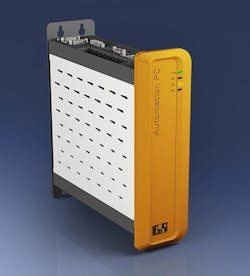As more microprocessor manufacturers design chips for specialized industrial uses, the greatest number of industrial applications remain well served by processors designed for high-end consumer applications, albeit when protected by a manufacturing-appropriate housing. The most recent example of this comes in the form of the Automation PC 910 from B&R Industrial Automation.
This industrial box PC features the third generation Intel Core i technology. Depending on application, users can select from i3, Core i5 and Core i7 CPUs with up to four cores along with the new QM77 Express chipset. According to B&R, this processor technology combination provides “the highest level of industrial computer performance that is currently available.”
Allowing for the selection of processors and housing types is not new to B&R, as all previous Automation PC models permit the user to mix and match CPU performance within different sized units. For example a quadcore CPU can be used in a single-slot housing or a single core Celeron can be used in a five-slot housing.
Other features of the Automation PC 910 include two ports for Gigabit Ethernet, one serial, one modular serial port (e.g., RS485 or CAN) and USB 3.0 ports, as well as a serial ATA-based CFast card, which replaces the use of CompactFlash.
Explaining B&R’s choice of embedded Intel architectures in its industrial PCs, Robert Muehlfellner, B&R’s director of automation technologies, says the use of consumer computing technologies “enables us to integrate capabilities that used to require a separate PC connected to a controller. We can now eliminate that additional PC running Windows because we can integrate functionalities like Web servers right on the control device.”
Muehlfellner says B&R prefers not to drive its own hardware technology standards so that it can reduce the need to develop proprietary solutions. “We want to focus our R&D on providing powerful, easy-to-use technologies,” he says. “We don't want to focus on designing our own hardware architectures.”
B&R’s use of embedded PC architectures allows the company to combine all automation functions, such as sequential logic control, I/O handling and visualization, in a single processor.
“OEMs want their machines to do more — provide more data, add functionality — but don't want the complexity of spreading it over multiple processors,” Muehlfellner adds.
About the Author
David Greenfield, editor in chief
Editor in Chief

Leaders relevant to this article:
